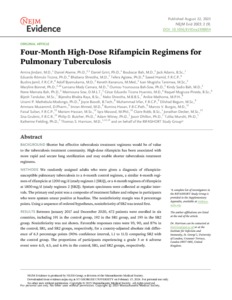Jindani, A;
Atwine, D;
Grint, D;
Bah, B;
Adams, J;
Ticona, ER;
Shrestha, B;
Agizew, T;
Hamid, S;
Jamil, B;
et al.
Jindani, A; Atwine, D; Grint, D; Bah, B; Adams, J; Ticona, ER; Shrestha, B; Agizew, T; Hamid, S; Jamil, B; Byamukama, A; Kananura, K; Mugisha Taremwa, I; Bonnet, M; Camara, LM; Bah-Sow, OY; Bah, KS; Bah, NM; Sow, M; Ticona Huaroto, CE; Mugruza Pineda, R; Tandukar, B; Raya, BB; Shrestha, N; Mathoma, A; Mathebula-Modongo, UP; Basotli, J; Irfan, M; Begum, D; Muzammil, A; Ahmed, I; Hasan, R; Burgos, MV; Sultan, F; Hassan, M; Masood, I; Robb, C; Decker, J; Grubnic, S; Butcher, PD; Witney, A; Dhillon, J; Munshi, T; Fielding, K; Harrison, TS
(2023)
Four-Month High-Dose Rifampicin Regimens for Pulmonary Tuberculosis.
NEJM Evid, 2 (9).
EVIDoa2300054.
ISSN 2766-5526
https://doi.org/10.1056/EVIDoa2300054
SGUL Authors: Jindani, Amina Butcher, Philip David Witney, Adam Austin Harrison, Thomas Stephen
![[img]](https://openaccess.sgul.ac.uk/116227/1.hassmallThumbnailVersion/EVIDoa2300054.pdf)  Preview |
|
PDF
Published Version
Available under License ["licenses_description_publisher" not defined].
Download (866kB)
| Preview
|
Abstract
BACKGROUND:
Shorter but effective tuberculosis treatment regimens would be of value to the tuberculosis treatment community. High-dose rifampicin has been associated with more rapid and secure lung sterilization and may enable shorter tuberculosis treatment regimens.
METHODS:
We randomly assigned adults who were given a diagnosis of rifampicin-susceptible pulmonary tuberculosis to a 6-month control regimen, a similar 4-month regimen of rifampicin at 1200 mg/d (study regimen 1 [SR1]), or a 4-month regimen of rifampicin at 1800 mg/d (study regimen 2 [SR2]). Sputum specimens were collected at regular intervals. The primary end point was a composite of treatment failure and relapse in participants who were sputum smear positive at baseline. The noninferiority margin was 8 percentage points. Using a sequence of ordered hypotheses, noninferiority of SR2 was tested first.
RESULTS:
Between January 2017 and December 2020, 672 patients were enrolled in six countries, including 191 in the control group, 192 in the SR1 group, and 195 in the SR2 group. Noninferiority was not shown. Favorable responses rates were 93, 90, and 87% in the control, SR1, and SR2 groups, respectively, for a country-adjusted absolute risk difference of 6.3 percentage points (90% confidence interval, 1.1 to 11.5) comparing SR2 with the control group. The proportions of participants experiencing a grade 3 or 4 adverse event were 4.0, 4.5, and 4.4% in the control, SR1, and SR2 groups, respectively.
CONCLUSIONS:
Four-month high-dose rifampicin regimens did not have dose-limiting toxicities or side effects but failed to meet noninferiority criteria compared with the standard 6-month control regimen for treatment of pulmonary tuberculosis. (Funded by the MRC/Wellcome Trust/DFID Joint Global Health Trials Scheme; ClinicalTrials.gov number, NCT02581527.)
Statistics
Item downloaded times since 11 Mar 2024.
Actions (login required)
 |
Edit Item |



